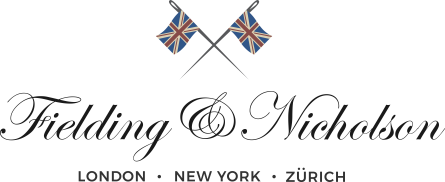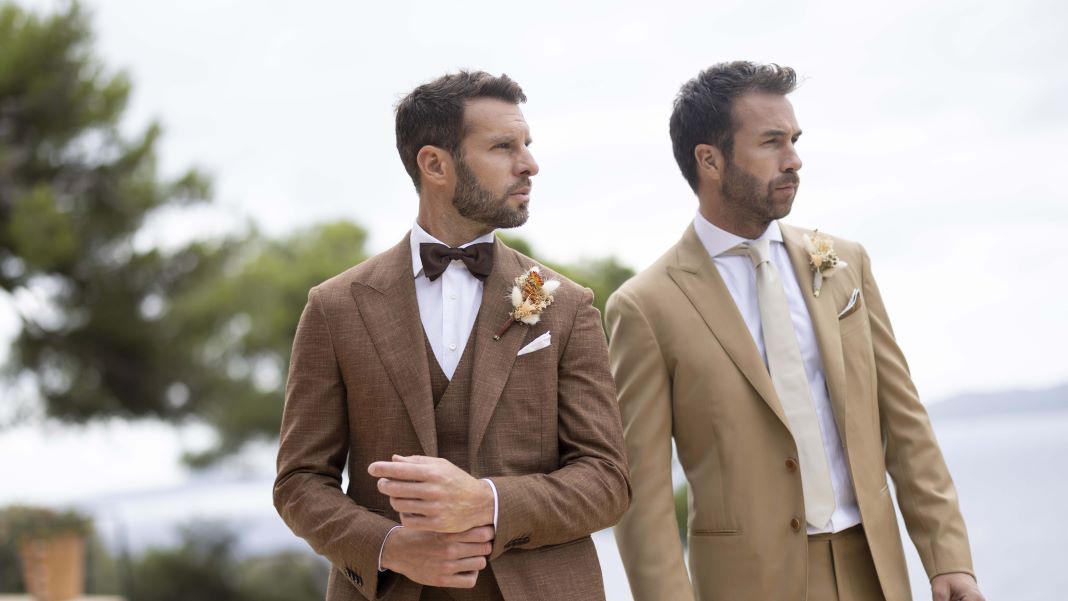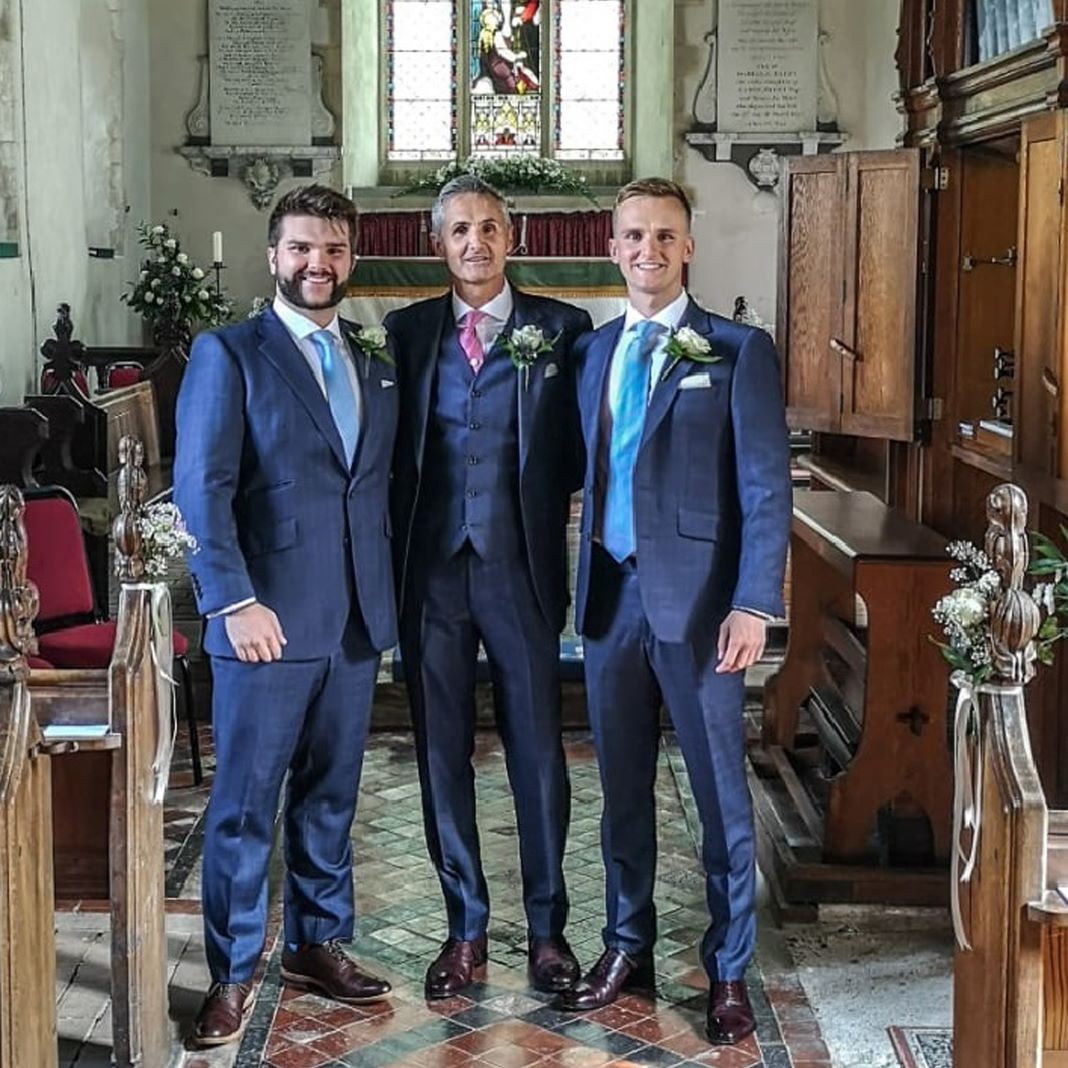Why Should the Groom and Groomsmen Wear the Same Suit?
Deciding whether the groom and his groomsmen should wear the same suit is a question many couples ask early in their wedding planning. It depends on your personal style, the formality of your wedding, and how cohesive you want your party to look. Matching suits create a smart and polished appearance in group photos and help guests easily identify the key members of the wedding party. But identical outfits are not the only option. There are ways to coordinate outfits without sacrificing individuality.
Here's What We Have Covered In This Article
Groom and Groomsmen Etiquette: What’s Appropriate?
Traditionally, the groom is the visual focus at the altar and his outfit reflects this role. Groomsmen tend to wear similar suits to each other with subtle differences that allow the groom to stand out. This arrangement supports the structure of the ceremony while also helping to keep the group coordinated.
In terms of etiquette, it is still widely accepted that the groomsmen’s suits should complement the groom’s attire without drawing attention away from him. For instance, if the groom wears a three piece suit in deep navy, the groomsmen might wear a two piece version in a lighter shade. This small change helps establish a clear visual hierarchy.
How the suits appear in photographs is just as important. A collection of outfits that are too dissimilar can look mismatched, whereas coordinated suits help maintain visual order. Consider using colour, tailoring, or fabric choice to bring contrast while giving each person a say in their look.
To learn more about wedding outfit norms and how to coordinate attire across the bridal party, see our wedding guest attire etiquette guide.
The Tradition of Matching Wedding Attire
Historically, groomsmen wore identical suits to the groom to confuse malevolent spirits or stop unwanted suitors from recognising the groom. This symbolic protection gradually became a way of expressing loyalty and unity during formal ceremonies. Matching attire served a functional purpose by presenting a well ordered and harmonious group.
Even now, many couples choose matching suits because of their clean appearance and connection to wedding tradition. This is especially common at formal events where tuxedos or black tie are expected. The appeal lies in creating a unified look that feels smart and considered.
However, matching does not always mean identical. Many modern couples opt for coordinated outfits with slight differences to reflect personal style. You might have everyone in the same colour range but with variations in fabric or accessories. This keeps the group looking consistent while giving each person a chance to wear something that suits them.
This history of wedding outfits explores how these traditions have shaped what grooms and groomsmen wear today.
Pro Tip 1: Include your photographer in suit planning if possible. They can offer advice on what colours and textures work best in your chosen location and lighting.
Modern Takes on Matching and Individuality
Wedding attire is becoming more personal, and that shift shows in how people dress for the big day. Some couples still like everyone to match exactly. Identical suits, ties, and shoes can create a simple and organised look. This option works particularly well for weddings with formal dress codes or classic styling.
For others, a curated mismatch feels more natural. This involves selecting a shared colour palette and allowing each groomsman to choose a suit within that theme. You might see different shades of grey and blue or a variety of cuts. This approach feels more relaxed and helps groomsmen feel confident in what they are wearing.
Partial matching is another flexible option. The group may all wear charcoal or navy suits, with the groom adding a patterned tie, waistcoat, or contrasting lapel. These details maintain a sense of unity while allowing the groom to stand out clearly.
Whether you go for matching or not, consistency in tone, fabric type, or accessory style helps keep the group looking aligned. Mismatched styles work best when they are intentional. Set clear guidance about colours and formality, so everyone knows what is expected and feels comfortable. For examples of how curated attire choices play out at real weddings, browse Brides.com’s guide to mismatched wedding parties.
When Does Matching Make the Most Sense? Dress Code and Formality
The decision to match often depends on the wedding’s dress code. A black tie or white tie wedding usually requires uniform tuxedos for both the groom and groomsmen. In these settings, guests expect formality and consistency. Any visual deviation could appear unpolished or out of place.
Formal or Black Tie Weddings
For black tie optional weddings, there is more room for variety. Groomsmen can wear matching dinner jackets, while the groom might choose a contrasting velvet blazer or a different lapel shape. These smaller details make the groom stand out without breaking from the expected level of formality.
Semi Formal or Outdoor Weddings
In less formal or outdoor weddings, the rules are far more flexible. Beach weddings, rustic barn ceremonies, and garden receptions lend themselves to light coloured suits, relaxed tailoring, and a more casual atmosphere. Matching may still be appropriate, but variation in shirt style, footwear, or linen versus cotton fabrics can add personality.
The most important thing is alignment with the venue and tone of the event. If you are marrying in a city rooftop venue with sleek styling, matching slim cut suits will suit the setting. In contrast, a relaxed countryside setting gives you freedom to explore textural contrasts and light seasonal colours.
Pro Tip 2: Always ask for fabric swatches before committing to suit rentals. Lighting at your venue can make navy look black or grey appear silver.
Need Help Styling Your Groom’s Party?
Book a one-on-one consultation with our wedding style expert and make your wedding day look as good as it feels.
How Can the Groom Stand Out While Staying Coordinated?
The groom’s outfit should always feel connected to the groomsmen’s attire but include subtle features that mark him out. A classic approach is to change the suit colour slightly. For example, if the groomsmen wear mid blue suits, the groom could wear a deeper shade of navy. It keeps things consistent while signalling who the main focus is.
Visual Differentiators That Work
Another way to differentiate is through texture or pattern. A herringbone fabric or subtle check in the groom’s suit will show up nicely in photographs. Tailoring details such as a shawl collar, double breasted jacket, or contrast buttons can also help.
Accessories are an easy and effective place to add distinction. The groom might wear a different tie pattern, a unique floral boutonnière, a pocket watch, or a pair of cufflinks with sentimental value. Even a simple fabric change in the waistcoat or a pop of colour in the socks can say something about personality and position.
Some couples also use lapel shapes and waistcoat cuts to vary the overall look. If groomsmen are in notch lapels and no waistcoats, the groom might opt for a peak lapel or an elegant double breasted waistcoat. These variations help maintain the hierarchy without disrupting the visual flow of the group.
Trending Looks: Curated Mismatch and Fabric Focus
Colour Palette Coordination
A coordinated colour palette can bring variety and cohesion at the same time. Using tones within the same colour family such as navy, steel blue, or sky blue offers consistency with personality. These subtle shifts add visual interest without the risk of clashing.
Texture and Material Differentiation
Adding texture is a subtle but effective way to distinguish between the groom and groomsmen. Think tweed for an autumn wedding, linen for a summer ceremony, or brushed wool for a more formal winter look. Different materials can elevate a basic suit into something that feels more personal.
Mixed Neutrals for Visual Balance
Combining neutral tones like beige, taupe, light grey, and charcoal can create a harmonious group aesthetic. This is especially effective for weddings that lean into modern or rustic themes. Choosing suits in different but related shades ensures variation without sacrificing balance.
For more inspiration, see this GQ feature on wedding suit styling and texture mixing.
Seasonal and Venue Suit Choices
Match the Suit to the Setting
Think about your venue and how it influences the level of formality. A beachfront wedding often calls for unstructured, breathable suits in lighter colours. A cathedral wedding typically means darker suits with a sharper, traditional cut. Rooftop venues favour more modern tailoring while barn or garden locations allow for relaxed fabrics and earth toned palettes.
Fabric Weight and Colour Based on Climate
Wearing a wool suit to a beach wedding will feel uncomfortable and out of place. Lightweight fabrics such as cotton, linen, or blends with breathable weaves suit warmer climates, while heavier fabrics like tweed or brushed wool are better for autumn and winter settings. Lighter colours reflect heat and work best for outdoor weddings in spring and summer.
Planning for comfort and appearance is equally important. Seasonal choices affect not only how the party looks but also how confident and comfortable everyone feels.
Don’t Guess the Dress Code
Access our full formalwear checklist to avoid mismatches and last-minute panic.
Groom Bonding: Suiting as a Group Experience
Sharing the experience of choosing suits has become a big part of modern wedding planning. Grooms are including their mates in fittings, group consultations, and even events like “swatches and scotches” sessions where fabrics are reviewed over drinks. These gatherings bring a sense of occasion to what could otherwise feel like a chore.
This process builds camaraderie and gives everyone a chance to voice preferences around fit, colour, and comfort. Some groups explore personalisation together. Options like embroidered initials, inside jokes stitched into the lining, or selecting different cufflink designs help create a shared but personal memory.
Suiting can be more than a practical choice. It becomes an experience that adds meaning to the wedding day and gives the groomsmen a story of their own to tell.
Budget, Fit and Etiquette: Choosing with Consideration
Affordability for Groomsmen
Not every groomsman has the same financial comfort zone, so choosing suits that are stylish yet accessible makes a big difference. Some couples contribute towards the cost or offer to cover accessories such as ties or pocket squares. Where possible, consider rental options that provide the same level of quality and cohesion without the full expense of purchasing.
Using reputable suit rental companies ensures consistency across fits and colours. It also allows for last minute size swaps if needed. Retailers that specialise in wedding packages often provide groomsmen bundles that include everything from the jacket to the cufflinks, making the process smoother.
Fit Inclusivity and Comfort
A good suit should fit every body type comfortably. Look for brands that carry a wide size range, including short, long, athletic, and plus sizes. Comfort leads to confidence, and when each groomsman feels well dressed, the energy on the day is noticeably better.
When arranging fittings, make sure there is enough time for minor alterations. This ensures trousers are the right length, jackets sit well on the shoulders, and sleeves don’t bunch. If you’re not sure how early to begin, start with this wedding budget breakdown for groom’s attire to help with timelines and costs.
Who Pays and How to Handle It
Traditionally, groomsmen pay for their own suits unless the couple has offered to cover part or all of the cost. This varies depending on the budget, style of the wedding, and how much flexibility each person has. Clear communication makes this process more straightforward. Agree on a budget early and discuss what’s expected so everyone has time to plan.
If budget is a concern, consider allowing groomsmen to wear suits they already own within a shared colour palette. This makes it easier financially while still giving the group a coordinated look.
When to Buy or Rent Suits: Timeline Tips
Planning Ahead and Managing Fittings
As a general rule, suits should be ordered or booked at least three months before the wedding day. This allows time for fittings, exchanges, and alterations. Aim to have the final suits ready and hanging in wardrobes at least four weeks before the event.
Retailers often have seasonal demand spikes. If your wedding falls during peak times like spring or early autumn, order sooner to avoid stock issues or rushed fittings.
Alteration Advice and Emergency Options
Even ready to wear suits often need slight tailoring. Factor in two weeks for basic adjustments such as sleeve shortening or waist tapering. Most high street suit shops offer these services or can recommend a local tailor.
For any last minute issues, online services with express delivery can offer a backup. These can be useful in a pinch, though they are best treated as a fallback rather than a main plan.
Creating a shared spreadsheet or group chat for suit updates helps keep everyone on track. Include links to the preferred retailer, important dates, and fitting appointments. A little planning goes a long way in keeping the process smooth for everyone involved.
Real Weddings: How Couples Made It Work
Colour Shift Examples
In many weddings, grooms opt for a suit that stands out subtly against the backdrop of their groomsmen. One couple chose a classic navy for the groom while the groomsmen wore mid blue. The result was a smooth transition of tone that looked clean and elegant in photos. Another groom wore charcoal grey while his party wore light grey, creating a soft contrast without drawing too much attention away from the group look.
Accessory Swaps
Some couples rely on accessories to define the groom’s outfit. One popular example is giving the groom a floral or coloured tie while the groomsmen wear something plain or neutral. You might also see boutonnières that are more elaborate for the groom, or waistcoats that introduce pattern and texture just for him. These elements are small but impactful.
Fabric Contrast
A groom might wear a wool blend suit with a smooth finish while his groomsmen are in textured tweed or linen. These combinations work especially well in rustic or vintage settings, giving the entire group personality without losing balance. As shared in a wedding forum, one groom opted for a velvet blazer while his groomsmen wore traditional worsted wool, creating a visual difference that photographed brilliantly.
These approaches allow couples to personalise the look while preserving a coordinated feel. For ideas that align with your style, take a look at our guide to suit fabrics by season.
Cultural and Religious Customs
Weddings vary greatly across cultures, and the attire often reflects deeper traditions and symbolism. In South Asian weddings, it’s common for grooms to wear a sherwani while the groomsmen wear kurta pyjamas or matching suits in coordinated colours. The focus is on opulence, embroidery, and rich fabric.
In Jewish weddings, grooms often wear a kippah and a tallit, sometimes with a traditional black suit or a formal frock coat. The groomsmen may coordinate with similar suits but keep the accessories more reserved.
African weddings may feature brightly patterned fabrics, often with custom made suits or agbadas. These garments showcase cultural pride and personal heritage. Grooms often wear bolder versions of the same material, while the groomsmen support the look with a simplified cut or detail.
Orthodox Christian ceremonies often require traditional attire, especially in Eastern European communities, where long coats or religious garments are part of the visual identity. The groom and groomsmen’s looks follow the expected custom while making room for subtle personal touches.
Final Style Recommendations
Coordinated or Contrasted?
To help decide what works best, start by reviewing the dress code, venue, and personal style. If your event leans formal, a full match across the party maintains symmetry and meets expectations. If your wedding is more relaxed, coordinated colour palettes and fabric contrasts bring individuality without disrupting cohesion.
Visual Hierarchy Matrix
-
Full Match: Groom and groomsmen wear identical suits. Best for black tie or highly formal weddings.
-
Coordinated: Suits in similar shades or styles, with the groom adding visual cues to stand out. Works for semi formal settings.
-
Contrasted: The groom wears a suit that’s clearly different in colour or fabric. Suitable for outdoor or creative weddings.
Consider working with a stylist or a rental consultant to simplify decisions and keep everything aligned. And above all, choose outfits that reflect your personality while still feeling like part of the group. You will feel more comfortable, look confident, and enjoy the day that little bit more.
Planning a Wedding? Let’s Make It Easy
From suits to schedules, our experts simplify it all. Tailored planning support for the modern couple.




